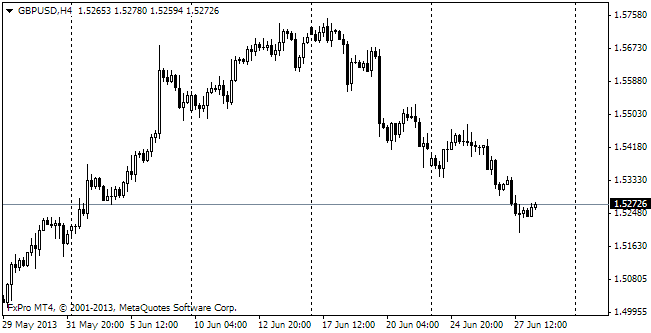EUR/usd
The pressure didn't weigh on the markets for long. There is a strong feeling that there is little that can distract investors from buying the US stocks: neither overbought markets, nor geopolitical troubles in Europe, nor bringing of the Fed's rate increase closer by half a year. The decline of the US stock indices caused by yellen's comments on Wednesday was bought out yesterday and by now we've returned to the same positions as last week and are generally in the area of record highs. Anyway, we can't say the same about the euro/dollar. Yesterday purchasing of dollars against the EU currencies continued. As a result, at some point the euro fell to 1.3750. Now the pair is consolidating around 1.3780. Most likely, today – at the end of the week – we'll see attempts to take profits from the decline and another test of 1.3800. bears in their turn can continue putting pressure, until bulls are at full strength. The area of 1.37 can become a bearish target and the tide of stop-orders below 1.3750 will help to reach in a relatively short time. Now we talk only about possible variants: either a limited sluggish pullback due to the profit-squeeze or further pressure on the pair. The levels of 1.3800 and 1.3750 can become indicative for these two variants. The way in which the pair will behave at these levels might prompt the next direction (further movement along the intraday trend or a reversal). We don't expect any important macroeconomic statistics on the eurozone today, except for the current balance. But this indicator usually doesn't have much influence on the pair's performance. All attention is again focused on the EU summit, the second day of which will be devoted to the same discussion of sanctions against Russia. For the markets and the euro it will be more favourable if sanctions aren't too tough. It will ensure calm closing of the week on the threshold of the important economic sentiment indexes, scheduled for release next week.
GBP/USD
The British pound was also too weak yesterday to resist the pressure of the US dollar. The pound/dollar tumbled down to 1.6480, i.e. by almost two figures for less than a day. Among the scheduled releases there are only budget performance statistics. Separate data are of little importance here and the general situation is quite clear – deficit is shrinking due to the impressive economic growth rate caused by increased tax revenue and decreased social benefits. Yet, the sterling is under threat in view of the BOE's negative attitude to the high rate of the national currency.

USD/CAD
Buyers of the canadian dollar seem to be deep down in low spirits. USDCAD had been showing impressive growth before the Fed's decision and after it continued its rally. Yesterday the pair rose as high as 1.1277, which is a five-year low. In our opinion, this pair is quite a good leading indicator of investor sentiment. The pair's growth is still speaking about the intention to go into the US assets against the background of faster economic growth. Accordingly the same movement may also happen in other currencies in the coming days. This scenario can be spoilt only by sharp deviation of today's inflation and retail sales statistics in Canada, which may shift the focus of attention to the country's fundamental indicators.

gold
Gold has received a hard blow this week. The futile attempt to break through 1400 on Monday convinced bears of their invincibility. The high, hit that day, makes 1392 dollars per troy ounce. Yesterday the price of Gold fell already to 1320. But even for those who count on further growth it would be more reasonable to wait for a while, the correction is probably not over yet.
